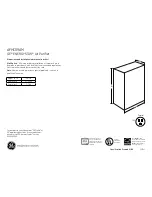
14
SERVICING AND MAINTENANCE
cont.
Charging Refrigerant:
• Charging a system in the field must be based on
determination of liquid sub-cooling and
evaporator superheat. On a system with a
thermostatic expansion valve liquid sub-cooling
is more representative of the charge than
evaporator superheat but both measurements
must be taken.
Before Charging:
• Refer to the Unit Nameplate to determine the
proper refrigerant to charge the system with.
• The unit being charged must be at or near full
load conditions before adjusting the charge.
• Units equipped with hot gas bypass must have
the hot gas bypass valve closed to get the proper
charge.
• Units equipped with hot gas reheat must be
charged with the hot gas valve closed while the
unit is in cooling mode.
• After adding or removing charge the system
must be allowed to stabilize, typically 10-15
minutes, before making any other adjustments.
• The type of unit and options determine the
ranges for liquid sub-cooling and evaporator
superheat. Refer to Table 1 when determining
the proper sub-cooling.
• The vertical rise of the liquid line must be
known in order to adjust the sub-cooling range
for proper charge.
• Units equipped with low ambient (0°F) option
see special charging instructions at the end of the
charging instructions.
Checking Liquid Sub-cooling:
1.
Measure the temperature of the
liquid line
as
it leaves the condenser coil.
2.
Read the gauge pressure reading of the
liquid
line
close to the point where the temperature was
taken. You must use liquid line pressure as it
will vary from discharge pressure due to
condenser coil pressure drop.
3.
Convert the pressure obtained in Step 2 to a
saturated temperature using the appropriate
refrigerant temperature-pressure chart.
4.
Subtract the measured liquid line temperature
in Step 1 from the saturated temperature in Step
3 to determine the liquid sub-cooling.
5.
Compare calculated sub-cooling to TABLE 1.
for the appropriate unit type and options.
Checking Evaporator Superheat:
1.
Measure the temperature of the
suction line
close to the compressor.
2.
Read gauge pressure at the
suction line
close
to the compressor.
3.
Convert the pressure obtained in Step 2 to a
saturated temperature using the appropriate
refrigerant temperature-pressure chart.
4.
Subtract the saturated temperature in Step 3
from the measured suction line temperature in
Step 1 to determine the evaporator superheat.
5.
Compare calculated superheat to TABLE 1 for
the appropriate unit type and options.
TABLE 1
Sub-
cooling
(°F)
Superheat
(°F)
Sub-cooling
W/Hot Gas
Reheat (°F)
Air Cooled
Condenser
12-18* 8-15** 15-22*
Evaporative
Cooled
Condenser
6-10* 8-15** 8-12*
Water
Cooled
Condenser
6-10* 8-15** 8-12*
* Sub-cooling must be increased by 3°F per 20
feet of vertical liquid line rise for R-22 and 2°F
for R-410A
** Superheat will increase with long suction line
runs.















































